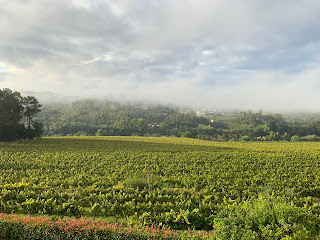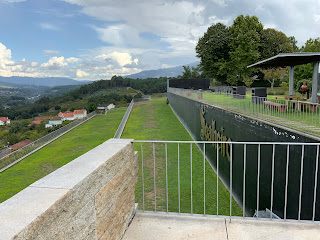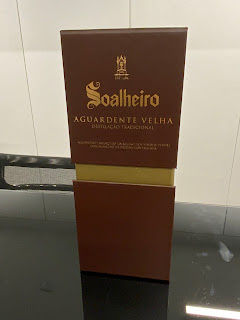September 11, 2023 From Solar das Boucas in Portugal to Castel de Armans Winery in Spain, snack at Soalheiro Winery
We got up, took one last look our our window at the fog in the vineyard, and packed and at 9:30 went down for breakfast. Today I ate two fried eggs with ham and cheese and Suzette made a ham scrambled egg, and cheese sandwich.
We each ate one of the Portuguese pastries that are custard in a tart shell called “pastel de nata”. I also ate a couple of fried eggs with ham and cheese and a freshly baked roll buttered and spread with Boucas’ own plum preserves and a cup of yogurt with diced fresh plum from their trees.
They gave us a bottle of Albariño, which turned out later to be bad, and a bottle of the lovely homemade plum preserves from plums from their trees. Our impression was that it was a wonderful experience at $170.00 per night.
To have your own wonderful room in a mansion in the middle of an 85 acre vineyard with no other guests was heavenly and very relaxing.
After breakfast we drove from the winery in the vino Verde wine district of Portugal toward our destination, a winery in the Ribeiro wine district of Spain. The Minho river is the boundary between Spain and Portugal, so the distance was not that great.
Before we left, Suzette suggested that we might be traveling near the most famous archeological site in Galicia, Santa Trega, so we decided to go there. As soon as we crossed the Minho River bridge and came to the Town of A Guarda we saw the sign for Santa Trega and started up the road that climbed up over 1100 feet until we came to the site perched in an ox bow on the side of a mountain between two mountain peaks with a view in both the direction of the Atlantic Ocean and the Minho River bay. An unparalleled observation point for many miles in both directions and an unparalleled defensive position.
A view of Suzette in the house with the Atlantic behind
The Minho River side and entrance
Here is what Galicia tourism says about it.
The settlement, 341 metres above sea level, was home to about 5,000 people during its heyday, the first century BC, and was one of the largest in the whole of the northwest of the Iberian Peninsula. The majority of its dwellings were oval in shape, but there are some rectangular ones, with rounded corners, proof of Roman influence. Although it first sight it may seem rather chaotically laid out, there is in fact a logical order based on “family units“, which you might like to work out for yourselves, whilst you discover the rock carvings inside and outside the walls. Its inhabitants were economically self-sufficient, making pottery, jewelry, cloth and tools that you can see for yourselves in the archaeological museum back in the town.
Santa Trega was a Celtic fortified hill town. The Celts preceded the Romans in dominating much of Europe.
We took pictures galore and then drove up to the top of the mountain that had restaurants and souvenir shops selling Celtic themed items. The view was spectacular and we were happy we visited the site.
We then recrossed the Minho back into Portugal and drove to Soalheiro Winery for a tasting and snacks. The winery has won many awards including being named one of the best 150 wineries in the world.
The wines
The tasting room and store
Some of their vineyards
We went because we saw a feature on the winery in a wine magazine in Amares and bought a bottle of Soalheiro‘s rose blend of Albariño with Pinot noir, which we liked very much that really focused our attention on the vineyard.
When we got there Suzette went on the tour of the vineyard and I sat in the shade and read.
When the group returned we were given a description of the family history and the production and label history. Soalheiro produces mostly Albariño and blends with Albariño, some more successful than others.
We tried five wines and liked only one and felt none compared to their rose, except an Albariño raised on a granite dominated hillside and a light very drinkable red made from the Tinto grape until the aguardiente which I think is the same as eau d vie was poured. The aguardiente was actually a house made eau d vie from 100% Albariño grapes skins and aged 20 years. It was an awesome drink that reminded me of the eau d vie I bought at Chateau Nerthe years ago.
The winery’s description
Soalheiro Aguardente Bagaceira Velha is produced by distilling the remaining skins after the pressing of Alvarinho at Soalheiro. Back in the day, all grape producers would make small distillations for their own consumption and we are no different. In the early days of our winery, Joao António Cerderia created a quality Bagaceira that aged for many years in oak barrels. After tasting it each year, our winemaker decided that the Aguardente Bagaceira Velha would benefit from at least 20 years of ageing. The spirit ages in oak barrels, from which it extracts colour and structure that complement the intense aroma of the Alvarinho variety.
We had made a mistake in ordering our tasting and actually ordered four snacks instead of two and we could not eat even one snack for two persons because they were mostly ham, salami, a firm cow cheese, and a soft goat cheese with marmalade and the local honey and bread.
The snack plate for two. We were served two plates.
We have noticed that our bodies’ capacity to absorb fat is far less than the average Spaniard or Portuguese. The winery happily pack the uneaten 1 1/2 trays of ham, salami, and cheese for us while I nought a bottle of aguardiente and we left at 4:30 because we had promised the Castel de Armans folks we would arrive by 7:00.
When we arrived at Castel de Armans at 6:15 there was no one to assist us and the lady in reception grudgingly checked us in because she was the wine maker and she was working as fast as possible to harvest and ferment the grapes these days and had no time to divert her attention from the job of getting the harvest in.
Then Suzette got an upset stomach and went to bed, so I read and blogged and watched the workers washing what appeared to be hundreds of plastic close-able stackable containers to place the wine grapes in.
Castel de Armans’ extensive fields
I ate a few carrot sticks and will eat the last two pieces of Santiago cake that we bought at the gastronomic festival in Cambados for dinner and then a few more bites of the heavy brown bread, but this time with a drizzle of olive oil. Another no meat fat dinner.
We will stay at this winery for four days and will probably get to see the craziness that everyone will go through to get the grapes harvested and into the fermentation tanks.
The tasting guide at Soalheiro told us the family and crew are working nearly 24 hours a day now as we watched the son, who is the wine maker clearing a traditional Portuguese stone crushing vat that had been crushed traditionally with feet early in the morning of red wine at 3:30 in the afternoon, although he was using a hydraulic pump.
The next few days could be the most exciting in terms of activity in the vineyard and the least satisfying as Hotel guests.
Bon Appetit




































No comments:
Post a Comment